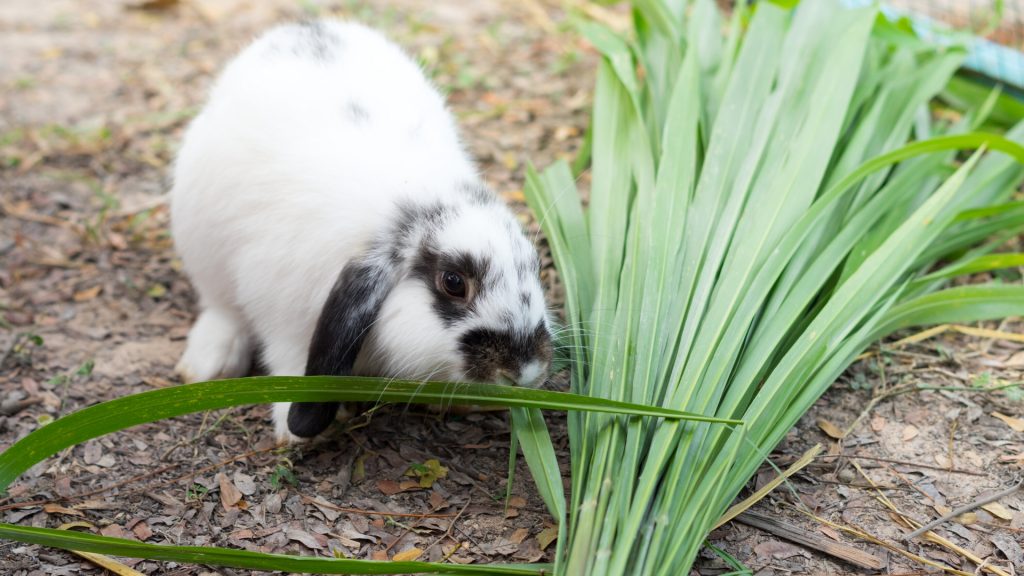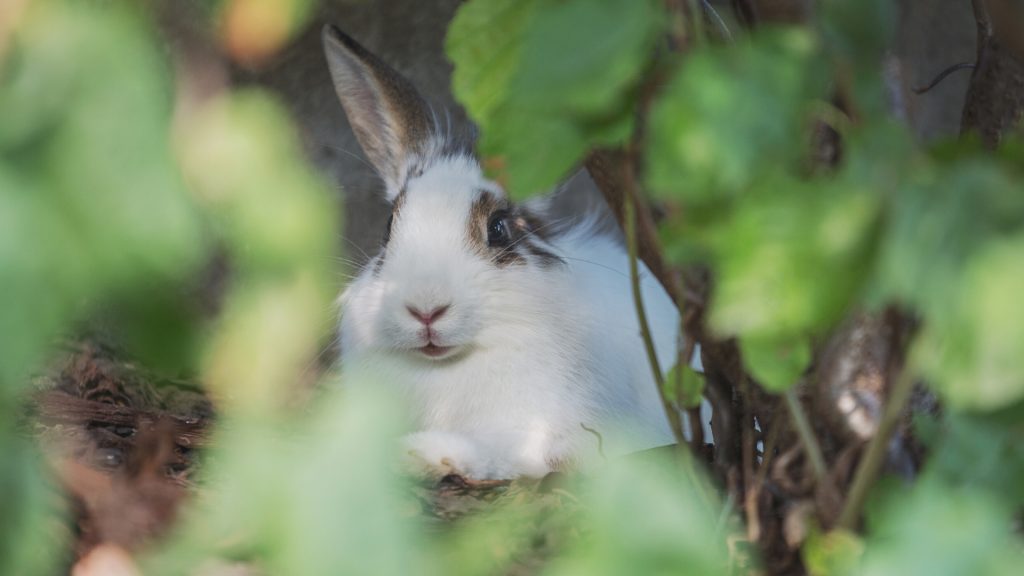Although most people like seeing rabbits in their yard, they can cause a lot of damage and some even think of them as pests. These long-eared animals have a voracious appetite for fruits and vegetables and can wreak havoc in gardens. This is why people can become desperate in their fight against rabbits and turn to some unconventional methods such as mothballs.
Do mothballs repel rabbits? Mothballs don’t repel rabbits. Not only are mothballs ineffective at keeping rabbits away from your garden, but they are also highly toxic when used outdoors. They contain chemicals that can harm you and the wildlife around your home. The EPA has also stated that mothballs can only be used indoors.

The rest of this article will in greater detail cover the reasons to avoid using mothballs to repel rabbits, discuss tell-tale signs you have a rabbit problem, and go over some humane but effective ways to chase them away from your property. Let’s begin!
Why You Can’t Use Mothballs to Repel Rabbits
As the name implies, mothballs are designed to kill and repel clothes moths, carpet beetles, and other fabric pests. They contain highly toxic concentrations of the pesticides called paradichlorobenzene or naphthalene.
Regulated by the Environmental Protection Agency (EPA), mothballs are sold in solid form. As per their EPA-approved label, their intended use is restricted to indoors with polyethylene or polypropylene containers.
Mothballs cannot be used outdoors as animal repellents as they present a health hazard to humans, pets, and other animals. Likewise, mothballs can contaminate plants, soil, and water supplies.
Additionally, it is a violation of federal law to use mothballs in any manner that defers from the intended use. In short, don’t use mothballs outdoors as a rabbit repellent as it is unsafe and even illegal in some areas.
Signs That Indicate Presence of Rabbits in Gardens

Some methods of controlling rabbits are expensive. For that reason, you need to assess the damage in your garden to ensure that the problem caused by rabbits.
Rabbits typically feed at night. For that reason, catching them in the act is difficult. However, the following are some clear signs that indicate to a problem with rabbits:
- Small, pea-sized dropping scattered around the garden or found in small piles.
- Evidence of digging which includes the presence of burrows or holes.
- Cleanly cut damage to the stems and leaves of your plants resembling those made with gardening tools.
- The appearance of tufts of fur on thorny shrubs or fences.
- Plants that disappear overnight, particularly the new shoots and flowers of plants like beans, clover, peas, and lettuce.
- And the best sign of all, footprints left behind in exposed soil.
How to Repel Rabbits Without Harming Them
There are several effective methods for controlling rabbits that include implementing fences and the use of repellents. Additionally, proper management of attractants like pet food, bird feeders, and the removal of brush piles and brangles can discourage rabbits from entering your yard. The following are some of these methods:
Method 1: Barricading Rabbits From Gardens and Flowerbeds
Installing fencing around your garden is one of the best ways of keeping them out in the first place. Wire mesh or chicken wire fencing that is at least two to three-feet tall will keep rabbits out of your garden.
Additionally, it’s best to bury the bottom of the fence at least six inches in the ground. If you don’t bury the bottom of the fence, you will need to stake it down to prevent rabbits from crawling under it.
The simplest way to fence your garden is by using a temporary fencing kit. You don’t need any tools to install this fence, it’s quick and easy, and everything you need comes in one box.
- No tools required! This temporary fencing kit has everything you...
- Posts easily and securely anchors into the ground just by...
- Unique "Y" at the top of each post holds the fencing material in...
- Great for gardens, pets, camping, leaf containment, chickens,...
- Product is reusable!
In some instances, you might have individual plants you want to protect from rabbits. If that is the case, you can use a circular fence. Best of all, this fencing is adjustable, ranging from 27-inches high with a 72-inch diameter to 30-inches tall with a 60-inch diameter.
- Willow is a natural sustainable material.
- Simple assembly required.
- Simple installation required.
- Stands alone, but you can attach to stakes using wire or zip...
- Zip ties included to form the circle.
Method 2: Commercial Rabbit Repellents
A variety of commercial repellents are available that can prevent or reduce rabbit damage. Ideally, you should apply chemical repellents before rabbits appear and reapply them often, particularly after a heavy rainfall or watering.
However, their usefulness is somewhat limited, and many of them can’t be used near plants that humans eat. Additionally, most of these products work through an unpleasant odor or taste which can be unpleasant to some people.
Fortunately, there are a few commercial repellents available that are “stink-free” like Tomcat’s Animal Repellent Granules. Its active ingredients include essential oils of cinnamon, peppermint, and garlic, and this product is safe for use on edible fruits and vegetables. Likewise, it is pet-friendly and safe for use around people.
- The essential oils in Tomcat Repellents Animal Repellent...
- One easy step to protect your garden and landscape from rabbits,...
- The no-stink, long-lasting and rain-resistant formula protects...
- Apply liberally and evenly to the turf and soil using the shaker...
- Provides coverage across approximately 1,000 sq. ft.
Also the Liquid Fence Deer & Rabbit Repellent is a highly recommended product for repelling rabbits.
- REPELS DEER AND RABBITS: Deer and rabbits don’t have to eat...
- SPRAY ON PLANTS: Use to treat landscaped ornamental gardens,...
- RAIN RESISTANT: Ready-to-use liquid formula starts to work...
- HARMLESS TO PLANTS AND ANIMALS: Won’t harm plants and animals...
- APPLY YEAR-ROUND: No need to rotate with other repellent brands...
Method 3: Natural Rabbit Repellents
Pepper Based Spray
There are a variety of natural ways to repel rabbits. For example, spraying plants with a homemade hot pepper spray is an effective way of repelling rabbits. However, you will need to apply it frequently, particularly after any substantial rainfall.
Step 1: All you have to do is simmer three tablespoons of hot pepper flakes or ten diced hot peppers in a gallon of water for about 15 to 20 minutes.
Step 2: Next, let it sit for about 24 hours, strain it, and stir in a few drops of a natural biodegradable liquid dish soap to help it stick to plants.
Garlic Spray
Likewise, you can make a garlic spray by soaking a couple of cloves of minced garlic in a gallon of water for 24 to 48 hours. Strain out the minced garlic and add a few drops of biodegradable dish soap, and your garlic spray is ready.
Other Natural Techniques for Repelling Rabbits

- Irish Spring: Irish Spring soap has a strong smell, and placing shavings of it in hanging drawstring bags around the garden helps repel rabbits.
- Sulfur: Sprinkling dried sulfur around your garden is a great way to get rid of rabbits.
- Repelling plants: Rabbits can’t stand the smell of garlic and onions. Planting them around the perimeter of your garden can help repel them. Likewise, they also don’t like the smell of marigold and alyssum.
- Wind chimes: Rabbits are sensitive to noise, and placing a few windchimes or tin cans on a string help scare rabbits away. Wind chimes can also help with squirrels.
Things to Consider Before Starting a Rabbit Control Program
Rabbits can cause damage to your garden and landscapes, but they also carry diseases that can cause severe diseases in humans and pets. For these reasons, feel free to use our pest control methods if you suspect having rabbits in your yard.
However, you should consider the following three factors before starting with any pest control method:
- Make sure that rabbits are the problem. For example, techniques used to repel rabbits will not control damage from caterpillars.
- Assess the costs of the various methods. Additionally, consider the degree of effectiveness of every method used to repel rabbits.
- Think about your costs. Consider not only your monetary costs, but also those concerning your time, hazards to humans and pets, and environmental damage.
Note: Start with pest control methods for rabbits only after taking some time to examine all three factors.
Summary
We hope we have managed to explain why you should avoid using mothballs to repel rabbits. The good news is that now you have all the information you need to humanely repel these pests before they destroy your gardens.
You might consider sharing this information with family members and friends who enjoy working in their yards and gardens. Likewise, bookmarking our site for future pest problems might be a good idea. Best of luck!
List of Sources
Mothballs, National Pesticide Information Center
Pesticide Product Label, Homebright Original Moth Balls, Environmental Protection Agency
Rabbits, University of Florida Gardening Solutions
Schalau J., Wildlife Repellents, University of Arizona
Rescue Plants from Rabbits, University of Florida Extension
How to Manage Pests in Gardens and Landscapes: Rabbits, University of California
Zoonoses Associated with Rabbits, Washington State University
Repellents and Wildlife Damage Control, University of Georgia Extension
- How to Get Rid of Turtles | Proven Long-Term Solutions! - August 26, 2023
- How to Get Rid of Kingsnakes | Easy & Humane! - August 26, 2023
- How to Get Rid of Northern Water Snakes | Best Solutions and Preventative Measures! - August 19, 2023




